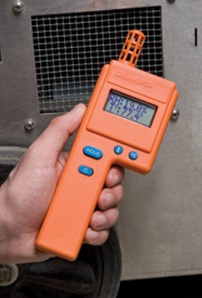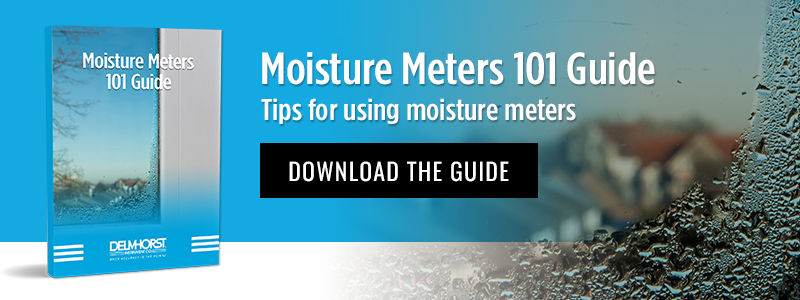For any tool, proper care and maintenance is a must if you’re going to make that tool last. This is especially true for highly complex tools such as thermo-hygrometers. These devices are an invaluable addition to the toolkit of restoration professionals, flooring installers, and anyone else who needs to be able to assess the relative humidity (RH) of the air at their worksite (or deep in a concrete slab).
What Are Thermo-Hygrometers?
 Thermo-hygrometers—sometimes called relative humidity sensors or RH sensors—are tools that can assess the amount of moisture in the air as compared to how much moisture would need to be present to achieve saturation. This information is given to the hygrometer’s user as a set percentage. 0% RH would be completely dry air, whereas 100% RH would be fully saturated air.
Thermo-hygrometers—sometimes called relative humidity sensors or RH sensors—are tools that can assess the amount of moisture in the air as compared to how much moisture would need to be present to achieve saturation. This information is given to the hygrometer’s user as a set percentage. 0% RH would be completely dry air, whereas 100% RH would be fully saturated air.
Different professionals use thermo-hygrometers for different tasks. For example, restoration experts might use them to take an RH reading in a room to determine whether that room has an excess of moisture compared to the rest of the building. This helps them to focus their efforts on the most moisture-compromised areas of a structure first.
Flooring installers use RH sensors with in-situ probes to test the humidity conditions deep within concrete slabs per the ASTM F-2170 standard. This lets them determine whether or not a concrete slab is ready to be built over.
Wood product manufacturers might use thermo-hygrometers to make sure that the RH conditions in their storage areas match those of the region where their wood products are going to be used—helping prevent various moisture problems later on.
However, it is important to note that, no matter the application, relative humidity sensors need meticulous care to ensure that they’re as accurate as possible. Without proper RH sensor care, these devices will eventually experience “sensor drift,” impacting their accuracy.
Reasons Why Thermo-Hygrometers Suffer Sensor Drift
There are two primary reasons why an RH sensor will lose accuracy:
- Exposure to Harmful Chemicals/Materials. When the sensor element of a thermo-hygrometer comes into direct contact with chlorides (such as salt) or corrosive chemicals in the air, it can become corroded. This impacts the accuracy of the RH sensor very quickly.
- Sensor Aging. Even without getting directly exposed to harsh chemicals, the sensor element can, over time and repeated exposure to the water in the air, become coated in dirt/dust or other contaminants in the air. This interferes with the sensor’s ability to function, causing it to become less accurate at measuring RH.
In both cases, the sensor element is being contaminated—the major differences are in the severity of the contamination and the suddenness of the effect. Once the sensor element is damaged, the best solution to restore the hygrometer’s functionality is usually to replace the sensor element.
Tips for Effective RH Sensor Care
So, how can you care for your RH sensor to make sure it’s as accurate as possible for as long as possible? A few tips to make your thermo-hygrometer last include:
- Avoiding Extreme Environments. Generally speaking, it’s best to use your RH sensor in environments that are within its recommended temperature and humidity range—between -20˚C to 60˚C (-4˚F to 140˚F) and 20% to 60% RH. Outside of these conditions, the accuracy of the meter may be temporarily affected, and prolonged exposure may have a permanent impact.
- Using Protective Sensor Coverings. Many thermo-hygrometer manufacturers offer protective coverings for their meters’ sensor elements. These membranes filter out many harmful chemicals and particles to prolong the useful life of the sensor element.
- Storing the Sensor Element in a Protective Case. When not in use, the sensor element (and the hygrometer itself) should be stored in a protective case that is sealed against the outside air. This will help protect the sensor element from contaminants when not in use, prolonging its useful life.
- Do NOT Directly Handle the Sensor Element. Sensor elements are very sensitive to contamination. As such, they should not be touched directly unless absolutely necessary. You should also avoid:
- Using compressed air on the sensor,
- Washing the sensor, or
- Allowing it to come into contact with any other material.
If you suspect that your thermo-hygrometer is suffering from sensor drift, you can test its accuracy by using a reference sensor to compare readings or by using a salt solution test kit. The test kit will generally come with specific use instructions, but some pointers to keep in mind when using these tools include:
- It generally takes at least 12 hours for a sensor left in a salt solution bottle to reach the intended RH level.
- Prolonged exposure to high humidity conditions (such as those found in a salt solution test kit) can cause damage to the sensor element. As such, the sensor element should not be left in the kit for more than 24 hours.
- Temperature stability is a must for ensuring accurate results. Temperatures for the test kit should be kept to the level recommended in the kit’s instructions—a variance of 1˚C (1.8˚F) could cause a difference in the RH reading of around 0.5% at the high humidity levels found in a test kit.
If your thermo-hygrometer’s sensor element is damaged, it should be replaced as soon as possible to restore optimal accuracy.
Need to know more about how you can use RH sensors and other moisture testing tools? Check out our free Moisture Meters 101 Guide at the link below, or contact Delmhorst Instrument Co.

Comments